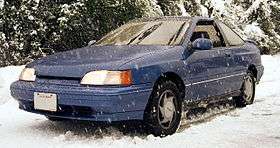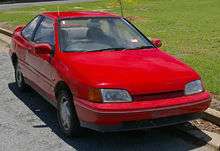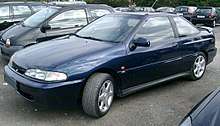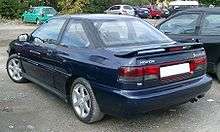Hyundai Scoupe
| Hyundai Scoupe | |
|---|---|
 | |
| Overview | |
| Type | Sports car |
| Manufacturer | Hyundai Motor Company |
| Also called | Hyundai S-Coupe |
| Production | 1988–1995 |
| Model years |
S-Coupe phase I (1989-1992) S-Coupe phase II (1992-1996) |
| Assembly | Ulsan, Korea |
| Body and chassis | |
| Class | Sports car |
| Body style |
Notchback Coupe |
| Layout | FF layout |
| Doors | Two (2) |
| Related | Hyundai Excel |
| Powertrain | |
| Engine |
1468 cm3 (89.5 cui) G4DJ SOHC 8v MFI |
| Transmission |
4-speed automatic 5-speed manual |
| Chronology | |
| Successor | Hyundai Tiburon |


The Hyundai Scoupe was a 2-door coupé based on the Hyundai Excel. The name, a portmanteau of "sporty" and "coupe," was pronounced "scoop".
The car was originally previewed at the 1989 Motor Show as the Hyundai SLC Coupe. When questioned, the South Korean company's executives said that `SLC` stood for Sporty Little Car.
S-Coupe phase I (1989-1992)
| 89-92 Hyundai Scoupe | |
|---|---|
| Overview | |
| Type | Sports car |
| Layout | FF Layout |
| Powertrain | |
| Engine |
Mitsubishi Orion 4G15 SOHC 8v Carburetor Hyundai G4DJ SOHC 8v Fuel Injection MPI |
| Power output |
56.5 kW (76 hp) 4G15 SOHC 8v Carburetor (All Market) 62 kW (83 hp) G4DJ SOHC 8v Fuel Injection MPI (Europe Market) 64 kW (86 hp) G4DJ SOHC 8v Fuel Injection MPI (Asia Korea DM) 60.5 kW (81 hp) G4DJ SOHC 8v Fuel Injection MPI (North American Market) |
| Transmission |
5-speed manual transmission 4-speed automatic transmission |
In 1989, the first versions of the Hyundai Scoupe was manufactured and sold in the Asia Market.
The Scoupe was front-wheel drive (FWD) and was offered with either a 5-speed manual transmission or a 4-speed automatic transmission.
The Hyundai Scoupe was equipped with a Mitsubishi Orion-series Mitsubishi Orion engine 4G15SOHC 8 valve (carburetor) engine with a displacement of 1468 cm3 (89.5 cui) and an advertised power of 56.5 kW (76 hp/77 PS) JIS net and 127 Nm (94 lb-ft) of torque with a top speed of 165 km/h (103 mph) and can reach 0- 60 mph 13.3© s or 0- 100 km/h 14.4© s.
In the mid-year of 1990, Hyundai expanded the market for the Hyundai Scoupe. The Scoupe versions and sub-models were offered for the Asia market and Europe market.
The European market had several Hyundai S-Coupe sub-models offered namely 1.5i, LS, GSi, LSi and the base. The base Hyundai Scoupe 1.5 was equipped with previous years 4G15 SOHC 8 valve(carburetor) while the rest of the sub-models were equipped with the Hyundai G4DJ (SOHC 8-valve) engine equipped with an Electronic Control Unit (ECU) which manages the fuel injection system (MPFI), a cooling system, improved fuel-air mixture system and emission control. All these additional parts helped in increasing the advertised power of 62 kW (83 hp/84 PS) DIN, 125 Nm (92 lb-ft) torque and improving fuel mileage
The Asian market on the otherhand did not have the sub-model designation but the Asian market Scoupe engine version was slightly more powerful compared to its European market. The G4DJ (SOHC 8-valve) had an advertised power of 64 kW / (86 hp/87 PS) JIS net and 125 Nm (92 lb-ft) if torque.
For next two years, both the Asia Korea DM and Europe market were offered similar versions and sub-models until the end of phase I in 1992.[2]
In the mid-year of 1990 until 1991, Hyundai Scoupe further expanded its market to North America. Versions of the Scoupe in this market were offered with either a 5-speed manual transmission or a 4-speed automatic transmission and were equipped with the Hyundai 4G15 analouge codenamed G4DJ (SOHC 8-valve) engine with a displacement of 1468 cm3 (89.5 cui). The engine was equipped with ECU (Fuel System Management), cooling system, fuel mixture and emission control sensors and had an advertised power of 60.5 kW (81 hp/ 82 PS (SAE net) and 123 Nm/ 91 lb-ft of torque.
S-Coupe phase II (1992-1996)
| 92-96 Hyundai Scoupe | |
|---|---|
| Overview | |
| Type | Sports car |
| Powertrain | |
| Engine | researching |
| Power output | researching |
| Transmission | researching |
Several changes came for 1993, when Scoupes got a facelift, including the current Hyundai "H" logo, new flush headlamps plus body-colored side moldings and redesigned front sheetmetal, taillights, and rear bumper. The Base and LS models came with a new and improved, In-house manufactured, 1.5l 12-valve, direct-port fuel-injected engine, called "Alpha". The 1,495 cc Alpha, with a 75.5 mm (2.97 in) bore and an 83.5 mm (3.29 in) stroke, produced 92 hp (69 kW) at 5,500 rpm and 97 lb⋅ft (132 N⋅m) of torque at 4,000 rpm in naturally aspirated form, with a 10:1 compression ratio, and 115 hp (86 kW) at 5,500 rpm and 123 lb⋅ft (167 N⋅m) of torque at 4,500 rpm when turbocharged, with a 7.5:1 compression ratio.[3] Turbos came only with 5-speed manual shift, while Base and LS models could have an optional 4-speed automatic.
The Australian spec S-Coupe GT Turbo has been road tested by several Australian magazines, returning times of 9.2-9.3 secs for 0–100 km/h and 16.8 secs for the 0–400 m dash.

Hyundai says the Scoupe was the first production application for Garrett Automotive Products' T15 turbocharger, which was new for the early 90's. The turbo unit includes water-cooled bearings and housings and an integral wastegate.
The naturally aspirated Alpha boasts a 14% increase in power over its 1.5L Mitsubishi-designed predecessor, and the turbo produces 42% more power.
A Lotus-tuned suspension[4] was installed in both Base and LS models, while a slightly firmer strut valving was used in the GT. This, combined with the 2,176 lb (987 kg) curb weight made the car an interesting driving sport compact considering the low MSRP.
The GT's EPA was 27 miles per US gallon (8.7 L/100 km; 32 mpg‑imp) city, and 33 miles per US gallon (7.1 L/100 km; 40 mpg‑imp) highway.
The 1988-92 "Base" models achieved 26 miles per US gallon (9.0 L/100 km; 31 mpg‑imp) city and 34 miles per US gallon (6.9 L/100 km; 41 mpg‑imp) Hwy for Manual Trans, and 25 miles per US gallon (9.4 L/100 km; 30 mpg‑imp) city and 32 miles per US gallon (7.4 L/100 km; 38 mpg‑imp) for Automatic.
The 1992-95 "Base" Alpha 1.5 engine models achieved 28 miles per US gallon (8.4 L/100 km; 34 mpg‑imp) city 36 miles per US gallon (6.5 L/100 km; 43 mpg‑imp) Hwy for Manual Trans and 25 miles per US gallon (9.4 L/100 km; 30 mpg‑imp) City and 34 miles per US gallon (6.9 L/100 km; 41 mpg‑imp) for Automatic.
The car was replaced by the Tiburon in 1996.
This car made an appearance on BBC Top Gear Series 13 Episode 2 as Richard Hammond's car for the challenge where the presenters are finding the perfect car for a 17-year-old driver.
The Scoupe GT (LS Turbo in the USA) was Hyundai's first attempt at a sports car and featured South Korea's first domestically designed engine with a cast-iron block and crankshaft. The engine contains an aluminum head, aluminum pistons and steel connecting rods. A special compact pentroof combustion chamber design with central spark plug location was incorporated to optimize engine efficiency. The engine utilizes a Robert Bosch GmbH electronic engine control system and a knock sensor.
References
- ↑ "Hyundai S-Coupe data catalogue". www.automobile-catalog.com. Retrieved 2018-09-18.
- ↑ "Hyundai S-Coupe data catalogue". www.automobile-catalog.com. Retrieved 2018-09-18.
- ↑ "Ward's Auto World, September 1992, at". Hyundaiclub.net. Retrieved 2011-05-11.
- ↑ "HYUNDAI MOTOR AMERICA - A BRAND HISTORY". HyundaiNews.com. February 2011. Retrieved 4 January 2015.
| Wikimedia Commons has media related to Hyundai S Coupé. |
Hyundai road vehicle timeline, North American market, 1984–present | ||||||||||||||||||||||||||||||||||||
|---|---|---|---|---|---|---|---|---|---|---|---|---|---|---|---|---|---|---|---|---|---|---|---|---|---|---|---|---|---|---|---|---|---|---|---|---|
| Type | 1980s | 1990s | 2000s | 2010s | ||||||||||||||||||||||||||||||||
| 4 | 5 | 6 | 7 | 8 | 9 | 0 | 1 | 2 | 3 | 4 | 5 | 6 | 7 | 8 | 9 | 0 | 1 | 2 | 3 | 4 | 5 | 6 | 7 | 8 | 9 | 0 | 1 | 2 | 3 | 4 | 5 | 6 | 7 | 8 | 9 | |
| Subcompact | Excel | Excel | Accent | Accent | Accent | Accent | Accent | |||||||||||||||||||||||||||||
| Compact | Pony | Elantra | Elantra | Elantra | Elantra | Elantra | Elantra | |||||||||||||||||||||||||||||
| Elantra Touring | Elantra GT | Elantra GT | ||||||||||||||||||||||||||||||||||
| Sport compact | Scoupe | Tiburon | Tiburon | Veloster | Veloster | |||||||||||||||||||||||||||||||
| Mid-size | Ioniq | |||||||||||||||||||||||||||||||||||
| Stellar | Sonata | Sonata | Sonata | Sonata | Sonata | Sonata | Sonata | |||||||||||||||||||||||||||||
| XG | Azera | Azera | ||||||||||||||||||||||||||||||||||
| Coupé | Genesis Coupe | Genesis | ||||||||||||||||||||||||||||||||||
| Full-size | Genesis | Genesis | ||||||||||||||||||||||||||||||||||
| Equus | ||||||||||||||||||||||||||||||||||||
| Crossover SUV | Kona | |||||||||||||||||||||||||||||||||||
| Tucson | Tucson | Tucson | ||||||||||||||||||||||||||||||||||
| Santa Fe | Santa Fe | Santa Fe Sport | Santa Fe | |||||||||||||||||||||||||||||||||
| Veracruz | Santa Fe (LWB / XL) | |||||||||||||||||||||||||||||||||||
| Minivan | Entourage | |||||||||||||||||||||||||||||||||||